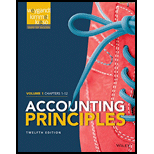
Concept explainers
(a)
Sales Journal: A sales journal is a special journal which records the credit sales transactions and the transactions which are of sales on account.
Purchases Journal: A purchases journal is a special journal which is used to record the credit purchases and the purchases made on the account in a business.
General Journal: A general journal is that journal which records those transactions which are not recorded in the special journal. The closing, correcting and adjusting entries are recorded in the general journal.
Cash Receipts Journal: A cash receipts journal is a special journal. This special journal records all the cash collections made in the business. The cash collections are made from the customers and the creditors. As these collections are very frequent in the business, this special journal is prepared.
Cash Payments Journal: The cash payments journal is a special journal. This special journal record all the cash payments and disbursements in the business. The cash payments are made in business for the purchases, expenses and for many other transactions. So, a special journal is prepared and the transactions are recorded in the special journal called as the cash payments journal.
Subsidiary Ledger: The subsidiary ledger is that ledger which is prepared for support of the main ledger. It contains all the details of the individual account of that particular ledger.
Adjusted Trial Balance: After the trial balance is prepared, some adjustment entries are made which are required. Now, to make the debit and credit columns equal another trial balance is prepared to record the adjusted entries, this trial balance is known as the adjusted trial balance.
To prepare: The accounts in the general ledger.
(b)
To prepare: The sales and cash receipts journal and record the transactions into it.
(c)
To prepare: The accounts receivable subsidiary ledger and the accounts payable subsidiary ledger.
(d)
To prepare: The entries and the totals to be posted in the general ledger.
(e)
To prepare: The trial balance at July 31, 2017.
(f).
The balance agreement of the control account and the subsidiary account.
(g).
To prepare: The adjusting entries in the general ledger.
(h).
To prepare: An adjusted trial balance.
Want to see the full answer?
Check out a sample textbook solution
Chapter 7 Solutions
Accounting Principles, Volume 1: Chapters 1 - 12
- Please provide the accurate answer to this financial accounting problem using valid techniques.arrow_forwardI need help finding the accurate solution to this financial accounting problem with valid methods.arrow_forwardCan you explain the correct methodology to solve this financial accounting problem?arrow_forward
- Can you explain this financial accounting question using accurate calculation methods?arrow_forwardI am looking for help with this financial accounting question using proper accounting standards.arrow_forwardI am looking for help with this general accounting question using proper accounting standards.arrow_forward

 AccountingAccountingISBN:9781337272094Author:WARREN, Carl S., Reeve, James M., Duchac, Jonathan E.Publisher:Cengage Learning,
AccountingAccountingISBN:9781337272094Author:WARREN, Carl S., Reeve, James M., Duchac, Jonathan E.Publisher:Cengage Learning, Accounting Information SystemsAccountingISBN:9781337619202Author:Hall, James A.Publisher:Cengage Learning,
Accounting Information SystemsAccountingISBN:9781337619202Author:Hall, James A.Publisher:Cengage Learning, Horngren's Cost Accounting: A Managerial Emphasis...AccountingISBN:9780134475585Author:Srikant M. Datar, Madhav V. RajanPublisher:PEARSON
Horngren's Cost Accounting: A Managerial Emphasis...AccountingISBN:9780134475585Author:Srikant M. Datar, Madhav V. RajanPublisher:PEARSON Intermediate AccountingAccountingISBN:9781259722660Author:J. David Spiceland, Mark W. Nelson, Wayne M ThomasPublisher:McGraw-Hill Education
Intermediate AccountingAccountingISBN:9781259722660Author:J. David Spiceland, Mark W. Nelson, Wayne M ThomasPublisher:McGraw-Hill Education Financial and Managerial AccountingAccountingISBN:9781259726705Author:John J Wild, Ken W. Shaw, Barbara Chiappetta Fundamental Accounting PrinciplesPublisher:McGraw-Hill Education
Financial and Managerial AccountingAccountingISBN:9781259726705Author:John J Wild, Ken W. Shaw, Barbara Chiappetta Fundamental Accounting PrinciplesPublisher:McGraw-Hill Education





